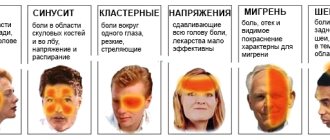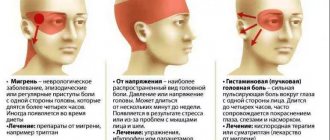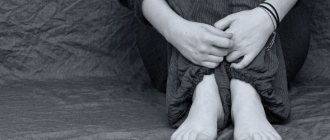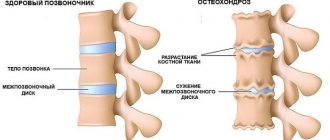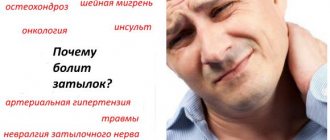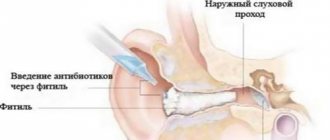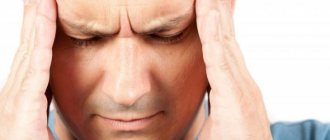Possible causes of burning in the back of the head
The localization of this symptom plays an important role.
After all, it can be used to roughly determine the cause of the disease. So, if a burning sensation is observed in the forehead and temples, then the cause may be a developing migraine or eye diseases or diseases of the nasal cavity. This is a reason to contact a neurologist, ENT doctor or ophthalmologist, depending on the cause. If the symptom is located in the parietal region and is accompanied by tinnitus, then most likely the cause is arterial hypertension. If sensations occur in the back of the head, this is characterized by the presence of cervical osteochondrosis. If the burning sensation spreads throughout the head, there have been changes in the endocrine system or there is an infectious process in the body. In this case, you should definitely visit a doctor for differential diagnosis of diseases.
Often, a burning sensation in the occipital region manifests itself in the form of short-term attacks. Therefore, people are in no hurry to seek medical help. But such changes are usually symptoms of more complex diseases that respond well to treatment in the initial stage. Therefore, when the back of the head burns constantly or momentarily, it is necessary to urgently undergo a medical examination.
There are many factors that provoke a burning sensation in the back of the head. In medical practice, the main causes are divided into two groups:
- Physiological
- Pathological
The first group includes:
- Bad habits. Constant intoxication of the body from drinking alcohol-containing drinks and smoking leads to vasoconstriction. This provokes the development of tissue hypoxia, resulting in burning, tingling in the back of the head and headache.
- Physical inactivity. Prolonged sedentary work, traveling by car and insufficient physical activity slow down blood circulation. This reduces its entry into the brain and disrupts its cellular nutrition.
- A sharp change in hormone levels. This condition is more common in women. With natural physiological changes, such as the menstrual period, pregnancy, menopause, testosterone and progesterone levels change. This negatively affects the cardiovascular system.
- Physical and emotional exhaustion. Heavy loads and lack of proper rest provoke the development of autonomic disorders. As a result, vascular tone increases, which interferes with the normal outflow of blood.
The second group of provoking factors includes the following diseases:
- Osteochondrosis of the cervical spine. As this pathology progresses, dystrophic changes occur in the vertebrae and surrounding soft tissues. This disrupts the blood supply to the brain. As a result, a sharp burning pain appears in the back of the head.
- Cervical migraine. With this disease, a burning sensation in the back of the head is accompanied by pain radiating to the frontal and temporal zones. Appears periodically.
- Neoplasms in the brain. As tumors grow, they destroy myelin fibers. This process causes a burning sensation from inside the skull.
- Cervical spondylosis. A burning sensation occurs against the background of the development of osteophytes. This pathology more often manifests itself in old age.
- Arterial hypertension. In this case, the back of the head usually burns in the morning. The pain can radiate to other areas of the head. The disease has no gender or age. Therefore, the risk group includes all adults and elderly people.
- Panic attack. This psychosomatic disease not only causes a burning sensation in the back of the head, but is also accompanied by tachycardia and a severe attack of fear.
A burning sensation in the back of the head can be supplemented by multiple symptoms, which help determine the etiology of the burning pain. For accurate diagnosis and differentiation of diseases, additional examination is carried out.
If a burning sensation appears in the back of the head, you should immediately contact a neurologist. After a physical examination, the doctor may prescribe laboratory and instrumental tests. Based on its results, the exact cause of the burning sensation is determined and treatment is prescribed.
The standard diagnostic complex includes:
- Clinical and biochemical blood test
- Electroencephalography
- Echoencephaloscopy
- 24-hour blood pressure monitoring
- Magnetic resonance imaging
The examination does not require additional preparation, so you can undergo it after consulting a doctor.
When the back of the head bakes, treatment is selected depending on the causes of the development of the pathological condition. The standard therapeutic complex consists of:
- Medication course. Anti-inflammatory and painkillers are prescribed, as well as medications that lower blood pressure, normalize blood flow and the functioning of the cardiovascular system.
- Physiotherapeutic procedures. To restore physical health, currents, laser and magnetic therapy, massage, and acupuncture are used. Acupuncture, baths and aromatherapy can help stabilize the psycho-emotional state.
- Compliance with the diet. Since burning pain in the back of the head is often a consequence of dysfunction of the cardiovascular system, it is recommended to adhere to a diet to relieve it. Fatty, fried, smoked foods are excluded from the diet.
The standard course of treatment can be supplemented with alternative therapy methods. But they should also be prescribed by a neurologist or naturopath.
While watching the video you will learn about pain in the back of the head.
When the back of your head burns, you should immediately consult a doctor and undergo a full examination. This will allow timely treatment to begin, which will significantly reduce the risk of developing severe forms of pathologies.
I found out that pain and burning in the back of the head can be for various reasons. To understand why the back of my head hurts, I began to analyze the possible causes and nature of the pain for each of them:
- An increase in blood pressure may be accompanied by pain in the occipital region of the head, dizziness, and palpitations. The pain increases when the head is tilted.
- This pain can occur when pressure inside the skull increases. This is accompanied by nausea and vomiting. Intensifies with loud sounds and bright light.
- A common cause is diseases of the cervical spine (osteochondrosis, etc.). With cervical osteochondrosis, there are frequent pains in the back of the head, temples and neck, accompanied by dizziness, nausea, and tinnitus. There may be darkening in the eyes, double vision of objects. With any movement of the head, the intensity of the pain increases.
- Inflammation of the neck muscles caused by hypothermia, drafts, and prolonged stay in an uncomfortable position can also be the cause of this illness. In this case, the main symptom is pain in the neck when turning, tilting the head, burning in the back of the head and shoulder.
- Inflammation of the occipital nerve causes severe attacks of burning in the occipital region of the head, which spread to the neck, back, and ears. Any head movements or coughing increase the pain.
- Vascular pain with spasm of the arteries, difficulty in the outflow of blood from the head, starting from the back of the head, spreading throughout the head. When coughing or lowering the head, the pain increases.
- There are pains in the back of the head associated with the profession. They arise from tension in the neck muscles when staying in one position for a long time (typical of transport drivers working at a computer). When moving the head, rubbing the back of the head, neck, the pain and burning sensation become less.
- Burning and pain in the back of the head can occur due to severe stress - the nature of the pain can be different.
- Pain in the occipital and frontal parts of the head can occur with heavy physical exertion. Tingling and heaviness appear.
- A burning sensation in the back of the head can occur due to a malocclusion, and when opening the mouth, a click is felt in the jaw joint.
After researching the possible causes, I began to analyze my symptoms:
- Blood pressure was a little high (143 over 91), but acceptable for my age.
- I did not measure intracranial pressure, but there was no characteristic increase in pain with loud sounds or increasing light brightness.
- The burning sensation was localized only in the back of my head, but there was no headache.
- The bite is fine.
- There was no stress or excessive physical activity.
- And most importantly, with any movements the pain did not intensify, but on the contrary, it was felt less. Moreover, it arose after working on a laptop for a long time.
The reason for my problems became clear. Although I knew that sitting in one position for a long time was harmful, I did not control myself enough, because time flies quickly when working, and I want to do more.
Having understood the reason, I did not go to the doctors - let them deal with more complex cases. I dealt with my problem with simple exercises and self-massage.
- Sitting on a chair with your torso straight, bow your head (under your own weight), slowly count to 20 (about 20 seconds), then straighten up, rest for the same amount of time, and repeat again. So 15 times.
- Place your thumbs on the edges of your cheekbones and clasp the back of your head with the remaining fingers of both hands. Inhale slowly (count to 10), look up, throwing your head back (while resisting the movement with your fingers on the back of your head). Then exhale the same slowly, tilting your head as far down as possible, but without straining your muscles. So 4 – 6 times.
- At the bottom of the back of the head (between the cervical vertebra and the skull), use your middle fingers to feel the painful point. Place your fingertips on it, make (clockwise) 15 rotational movements, then press on this point for 1.5 minutes, rest for 2 minutes. Repeat this 4 – 6 times.
To improve blood circulation, I tried to move my neck more often: I tilted my head forward, turned it left and right, tilted it towards my shoulders, pushed it forward, and did rotations. In addition to these exercises, self-massage helped. It's very simple:
- massage your ears with the palms of your hands;
- then, starting from the back of the head, massage the entire head with soft fingertips (palms should touch the ears throughout the entire procedure);
- After massaging everything, return to the back of your head.
This is how I managed to eliminate the burning sensation in the back of my head. And to prevent this problem from appearing again, I now work on a laptop with an alarm clock (remember the question and photo at the beginning of the article?). Every hour I turn it on and when I call for 15-20 minutes I go to warm up, walk around, and do something else.
Therapy
How to properly treat such a disease? What is important to do for this? How can I safely remove it? Many people are concerned about such questions. This will be discussed further.
After examination by a highly qualified specialist and identification of the main causes of the disease, the doctor is obliged to prescribe appropriate therapy.
There are various ways to eliminate a burning sensation in the back of the head. The simplest thing a doctor can prescribe is the use of pain relief medications. The drugs contain blockers of factors in the development of the inflammatory response. Due to this, swelling of the soft tissues is eliminated. The patient immediately feels better. Such medications act quickly, but for a short time.
Thus, in addition to painkillers, the patient should be promptly prescribed therapy. In some cases, the doctor may recommend chiropractic surgery.
Special manifestations of discomfort
- redness of the eyes;
- tachycardia (heart beats rapidly);
- throws into sweat;
- tingling in the head.
All these symptoms appear from time to time all together, sometimes only a burning pain in the head is felt.
Many patients complain of a burning sensation throughout the head. Less commonly, the burning sensation manifests itself in the form of itching inside the head, which can be compared to the feeling of sitting for a long time under the scorching sun.
This itchy pain may be accompanied by monotonous, slightly throbbing pain inside the head, rapid pulse, high blood pressure and other symptoms.
If it is the scalp that is bothering the burning sensation – this is due to exposure to allergens, then you need to refuse to eat food to which you are allergic or try to avoid sources that cause an allergic reaction. Severe heat in the head can also manifest itself in the form of attacks.
But pain in the head, similar to tingling with needles, may indicate not only overwork of the body, but also the presence of serious illnesses.
https://www.youtube.com/watch?v=62nANUcuMFc
When the head burns from the inside, this is not the only symptom that patients complain about. The following discomforts also appear:
- The whites of the eyes turn red.
- The heart begins to beat faster.
- Profuse sweating.
- Sudden feeling of anxiety, panic.
- There is a feeling of tightness and tingling on the scalp.
Osteochondrosis of the neck
Cervical osteochondrosis occurs as a degenerative process in the cartilaginous system of the spine. The tissues located between the vertebrae gradually become thinner. The cartilage begins to wear away, and as a result, the vertebrae touch each other even with the slightest movement. Irreversible processes occurring in the skeleton contribute to salt deposits.
The disease progresses and long-term compression of the capillaries in the cervical region appears, the brain does not receive enough blood. Afterwards, oxygen starvation sets in, causing the back of the head to burn. To alleviate the painful symptom, it is recommended to do a massage in a specialized treatment room. Engage in healing physical exercises to strengthen your back muscles.
A common disease with complaints of a burning sensation in the back of the head, which affects all segments of the world's population. High blood pressure can affect men, women, teenagers, older adults and even children. Nuchal heat and pain intensify with sudden movements. There are other symptoms of the disease - dizziness, increased heart rate, anxiety, and blurred vision.
A sympatho-adrenaline crisis, or also called a panic attack, is manifested by a malfunction of the nervous system, high blood pressure occurs, blood vessels dilate, a feeling of unreasonable fear appears, the heartbeat increases, attacks of suffocation are felt, the head and heart hurt greatly.
A burning sensation may occur due to the sudden flow of blood to the head. Peripheral vessels of the brain open. This condition is caused by severe physical and emotional stress, cancer of the adrenal glands, spinal cord and brain systems, or a history of great anxiety or a stressful situation.
Unpleasant sensations in the head with vegetative-vascular dystonia are almost impossible to relieve with analgesics and antispasmodics. When examined by a doctor, no abnormalities are detected. Patients diagnosed with VDS experience pain in different ways: some characterize it as a burning sensation, others as a feeling of fullness, numbness or emptiness.
Brain tumors
Demyelination of the brain occurs when there is a deficiency of myelin. Lack of the substance leads to the process of damage to the myelin walls of neurons. Afterwards, irreversible destruction of the nerve fibers occurs. The burning sensation is caused by tumors of benign and malignant origin. There is severe constant pain, analgesics do not help, there is a lack of appetite, nausea, the person constantly feels tired, and vision decreases sharply.
Other factors
Considering other causes of headaches and burning in the back of the head, we can safely say that they are also no less dangerous. Any discomfort can occur if the joints become deformed. The neck will no longer be flexible and mobile. To treat a disease, it is important to know the source of the disease. The reasons are varied. Most often in medical practice there are those that relate to changes in the dynamics of blood supply to the back of the head.
- If a circumstance occurs, the blood vessels of the posterior structures of the brain narrow, after which they experience a huge lack of air and a decrease in glucose levels occurs.
- If small blood vessels narrow.
- If small nerve endings are affected, the patient may be affected, which results in increased pain.
- If active blood flow to the posterior structures of the brain predominates, which negatively affects the blood circulation of the brain.
It is important to detect the cause in time and direct all efforts to eliminate it.
First of all, it is important to exclude various pathologies caused by old or recent injuries that could affect the development of the disease. Rule out arterial hypertension, clinical manifestations of acute cerebrovascular accident, because they can also contribute to the development of this unpleasant sensation. Patients often have a question: why does the back of the head and neck burn?
As noted above, problems associated with burning primarily lie in diseases of the spine. It is he who influences the sensations in the back of the head. When the disease occurs in a sick person, the sensitivity of the skin increases, which primarily leads to painful and unpleasant sensations.
If the back of your head burns very badly, you should initially keep in mind that the roots of the spinal nerves may hurt. Sudden, intensifying sensations may indicate that the patient's radicular nerve is being compressed. It is important to immediately identify this deviation and take appropriate measures.
It doesn’t matter what the cause was - nerves, stress, spinal pathologies or the use of care products. It is important to remember one thing: the reasons are different, and everyone has their own, individual, depending on many characteristic circumstances.
Physiological failures
Most people who complain that they have a headache have acquired factors that are not a sign of malaise. Such cases can be eliminated by changing habits and lifestyle. Causes of unpleasant headaches include:
- Chronic fatigue. Significant mental and physical stress with a lack of sufficient rest leads to vegetative-vascular failures. There is stagnation of blood and disruption of brain nutrition. General and focal symptoms appear - headache, inability of the body, of course, to perceive irritations. In this situation, a night sleep of at least 8 hours and a work regime that is not harmful to health are recommended.
- Hypodynamic lifestyle. Sedentary work—as a driver or at a computer—and lack of physical activity slow down cerebral blood circulation.
- Changes in the hormonal system. Women experience such changes during pregnancy or menopause. The production of estrogen decreases, this leads to disruption of the functioning of the organs that provide blood circulation in the body, which provokes headaches. In men, testosterone decreases, which can also cause discomfort in the head area.
- Having bad habits. Alcohol and nicotine, which contain toxic substances, affect the destruction of vessel walls and promote the growth of blood clots and blood clots. As a result, the capillaries located in the head, due to the influence of various toxic substances on them, become less elastic and durable. Brain tissues do not receive enough oxygen and blood, which is the source of headaches. After completely giving up the bad habit, the unpleasant sensation goes away on its own after two weeks.
Nervous overstrain
How long has it been since you last felt rested and relaxed? Don't remember? Stress, worries, a bunch of to-do lists with unfulfilled items can also cause discomfort. The head hurts from the depletion of the blood vessels in the brain, the circulatory feedback does not work correctly. Blood accumulates in the brain, and you may feel as if your skull is being squeezed in a vice.
Crying and tantrums also negatively affect blood circulation. Sometimes, due to prolonged hysterics, vascular tone decreases, and blood pressure drops so much that vomiting until the stomach is completely empty.
Recommendation. Spend 15 minutes every day on psychological relaxation - sitting in silence with the sounds of nature, meditation, yoga, positive affirmations. If the nervous system is already shaken, you are irritated with or without reason - visit a neurologist and psychotherapist.
Burning in the head: tests
According to many scientific studies, when diagnosing this disease, competent research is needed, since the quality of the research carried out depends on further treatment, its speed and prognosis for later life. Since the causes of burning in the head are extensive, the diagnosis should cover the entire spectrum of examination of the body.
The main diagnostic methods include:
- Examination by a therapist, passing basic laboratory tests. Refers to the first line of diagnosis.
- Examination by an ophthalmologist. Fundus examination helps in determining the cause of neurological origin.
- X-ray of the head. X-rays can help determine if there is a head injury.
- Electroencephalography. Allows you to assess the state of brain matter by measuring nerve potentials.
- MRI of the head and cervical spine. This diagnostic study allows you to determine the structure and presence of tumor formations in the brain.
- Examination by an ENT doctor. Consultation with this specialist allows you to exclude or confirm the presence of pathology in the nasal cavity.
- Consultation with an endocrinologist. Testing for hormones allows you to exclude or confirm the endocrinological cause of the burning sensation.
- Consultation with a gynecologist. Used exclusively for women. Allows you to judge the presence of gynecological diseases, menstrual irregularities, which provoke this symptom.
In order to determine the disease that causes a burning sensation in the head, various tests are performed. It is better to undergo all the tests prescribed by your doctor to rule out the presence of a serious illness.
What tests are prescribed for complaints of a burning sensation in the head?
- General examination by a therapist, general urine and blood tests.
- Consultation with an ophthalmologist.
- X-ray of the skull - to identify a tumor or injury.
- Electroencephalogram - allows you to detect the presence of sympatho-adrenal paroxysm.
- Echoencephalography - ultrasound examination of the skull - reveals disturbances in the blood supply to the brain, intracranial pressure, etc.
- Magnetic resonance imaging of the head to detect brain tumors or demyelination of nerve fibers.
Before starting treatment, you must find out what caused the burning and heat in your head. You need to visit a therapist, neurologist and possibly other specialists, take general blood and urine tests, and also make an appointment with an ophthalmologist. This is an initial consultation with doctors.
In addition, an X-ray of the skull is taken, a CT scan or MRI (magnetic resonance imaging) is performed. In this case, a standard set of studies is used.
If an anomaly is suddenly discovered in the brain area, then to accurately determine the disease it is necessary to undergo a tomography. This is the best method for diagnosing diseases in the head area. The patient is placed in a tomograph.
Its principle is based on the effect of hydrogen protons on the human body. After this, encephalography (or ultrasound) is prescribed. The patient's head is lubricated with Vaseline and an ultrasonic sensor is passed over it. The received data is displayed on the monitor. They need to be recorded and decrypted.
The last stage of the examination is electroencephalography. This method is based on recording nerve impulses emanating from the brain.
Using electroencephalography, you can find out in which part of the head the disorder occurred. All of the above methods of examining the head are painless, but effective in identifying serious diseases.
In the process of general diagnostics, the following facts are revealed:
- frequency of pain in the form of burning and tingling;
- the connection between pain and the body’s response to pain;
- nature of pain, intensity, duration, localization.
Differential diagnosis is a method that allows you to identify a disease in a person by excluding possible diseases due to the patient’s lack of obvious symptoms of the suspected diseases.
As a result, the correct diagnosis is made and proper treatment is carried out. There are special computer programs that help to most accurately identify the disease based on the detected symptoms.
Before starting pain treatment, a number of tests are carried out, including laboratory tests - they can look for signs of infection and inflammation. A visit to an ophthalmologist is mandatory for the patient.
A visit to this doctor is indicated in almost all cases of headaches, since there may be changes in the fundus of the eye that can only be determined by an ophthalmologist using special equipment; The examination also establishes the true cause of the headache. Plus, the ophthalmologist will evaluate the state of refraction, visual acuity and visual fields of the patient.
Medical diagnostic tests will help to identify the cause, make a correct diagnosis and explain why it’s hot in the head. For the examination you will need to apply and visit:
- a local doctor (therapist), he will give a referral to a cardiologist, neurologist, traumatologist or ophthalmologist;
- pass general tests - urine and blood;
- take an X-ray of the brain;
- undergo an electroencephalogram, echoencephaloscopy or MRI.
Best ways
Modern methods of manual therapy are divided into various methods:
- A method of subcutaneous therapy, where compactions and scars can be detected.
- A method of vertebral therapy, where the functions of the affected joints are completely restored.
- The cranial method is used for diseases of the brain. The specialist must massage the muscles of the neck and joints of the skull, which improves blood supply to the brain, relieves various painful symptoms, and improves brain function. Depending on the duration of treatment, the patient experiences an improvement in memory and a decrease in intracranial pressure, which has a beneficial effect on the patient’s well-being. Upon completion of this method, the patient is completely restored to all functions of the internal organs. Significant relief is possible.
- The method is visceral, aimed at providing a therapeutic effect on the patient’s internal organs. When using this method of manual therapy, the patient experiences a significant improvement in the condition and performance of the heart, kidneys, and intestines. The functionality of other internal organs is completely restored. This method is effective.
If the patient has a burning sensation in the back of the head, then this is a sign of osteochondrosis, and it is accompanied by complications such as hernia, vertebral artery syndrome. In this case, manual therapy must be used, expressing the following:
- in traditional spinal traction, which ensures straightening of the cartilage tissue of the intervertebral disc and eliminating compression of the radicular nerve;
- in massage, which enhances the process of microcirculation of blood and lymphatic fluid in the affected area;
- in reflexology, which triggers the mechanism of regeneration of pathologically altered tissues;
- in therapeutic exercises aimed at improving the functioning of the muscular frame of the neck.
The course of treatment for the patient must be developed individually.
In addition to manual therapy, another treatment is recommended for pain in the back of the head and burning sensation - medication. What is it?
For osteochondrosis of the cervical spine, the doctor should prescribe the following medications to the patient:
- anti-inflammatory drugs;
- drugs aimed at improving blood circulation;
- B vitamins.
It is not necessary to take pharmacy vitamins. You can pay attention to foods that are rich in them. This includes products with thiamine, riboflavin, nicotinic acid, choline, pantothenic acid. You should also consume folic acid.
If there are no objective reasons, the MRI did not reveal serious pathologies, there are no injuries, the doctor recommends that the patient use anti-anxiety medications that can prevent the patient from becoming restless and dejected. Antidepressants are recommended for many patients.
These drugs are recommended for headaches and burning in the back of the head, if manual therapy has not brought effective results. The drugs can also be used during therapy, in addition to the main treatment.
In addition to the above, it is important to use non-drug treatment.
To eliminate the burning sensation in the head, the following will help:
- A general massage that helps relieve back pain and burning sensations for no apparent reason. This is due to the positive effects on the nervous system.
- Acupuncture is the effect of needles on special points in the human body.
But all methods must be used strictly as prescribed by the doctor.
To treat a burning sensation in the back of the head and dizziness, the following is important:
- Make a competent selection of funds together with your doctor. The drugs should be taken in monthly courses twice or thrice a year.
- Find a competent specialist in manual therapy, osteopathy or acupuncturist. It is important to relieve muscle tension in the cervical region.
- After eliminating tension, you should buy a subscription for individual training with a yoga specialist. It is recommended to attend classes three times a week until you thoroughly study the class system. Then you can exercise on your own, but at least three times a week at home or in fitness training.
- Follow a daily routine: get plenty of rest, give up bad habits.
- Eat right and follow a special diet.
- It is advisable to learn breathing exercises with holding inhalation and exhalation, which will also help in the fight against headaches.
You should follow all recommendations and advice prescribed by your doctor.
Therapeutic measures to relieve burning sensation
Therapy for a burning sensation in the head involves getting rid of the disease that led to this symptom. Optimal treatment is prescribed after examination and identification of the cause. Having recovered from the disease, the feeling of heat in the head goes away. Hypertensive crisis, osteochondrosis of the neck and attacks of severe anxiety provoke disorganization of the blood supply to the brain.
To regenerate normal cerebral circulation in an outpatient setting or at home, the following therapeutic and preventive measures are indicated:
- The brain will be able to restore strength and restore healthy blood circulation with the help of manual therapy - massage, which should be performed by a qualified massage therapist.
- After an acupuncture session, the blood supply to the vessels of the brain significantly improves.
- Gymnastics and yoga without significant strength loads are recommended.
- The diaphragmatic breathing technique gives positive results.
- Normalization of work and rest schedules.
- Healthy sleep is the key to health, at least eight hours at night.
- Walking every day for 15-20 minutes, fresh air will help restore health.
- Proper nutrition normalizes the functioning of the body's systems and organs.
- Completely give up bad habits.
- If your entire head is affected by prolonged exposure to the sun, it is recommended to apply a cooling compress or take a cool shower.
Cervical osteochondrosis
Osteochondrosis is a disease associated with deformation of the vertebrae and degenerative changes in nearby tissues. There is a disruption in the blood supply to the brain, which leads to cephalgia, tinnitus, loss of vision, and sometimes disability. In recent years, this disease has been spreading at epidemic speed and affects young able-bodied men and women aged 25 to 40 years.
This kind of pain needs to be diagnosed.
Unfavorable factors include:
- prolonged sitting at the computer;
- talking on the phone with the receiver clamped between the ear and shoulder;
- sitting in a car for a long time;
- sedentary lifestyle.
A burning sensation in the occipital region of the head is the main symptom. Joining him:
- aching pain in the back of the head, neck;
- the shoulder burns, the hands may become numb;
- heat in the face;
- burning at the level of the shoulder blades.
The pain is quite strong and begins to intensify with movements of the head, eyeballs and spreads to the neck, shoulders, and back of the head.
With osteochondrosis, headaches often occur spontaneously. It is paroxysmal and the painful sensations do not gradually increase, but instantly reach their highest peaks. The attacks last about 10 minutes, mainly in the morning and reduce the ability to work, cause neuroses and changes in blood pressure.
Osteochondrosis is a degenerative and irreversible process, and in order to stop it, immediate examination and treatment is required. In addition to analgesics and antispasmodics, the patient is prescribed drugs that improve cerebral circulation and relieve muscle tension. Treatment is supplemented with vitamin B and nicotinic acid.
Provoking diseases
Diseases that can cause headaches:
- A common cause of burning, tingling and sensation of heat in the head and neck is cervical osteochondrosis. With this disease, the intervertebral discs in the spine of the neck are deformed, which leads to their degeneration. The normal blood supply to the head is also disrupted, and tinnitus may occur. The disease progresses quickly in those people who work at a computer or drive a lot. In addition to burning, the development of cervical osteochondrosis may be accompanied by: numbness of parts of the face, crunching when turning the neck, burning and tingling in the back of the head and neck. The pain intensifies after being in the same position for a long time, even after sleeping in an uncomfortable position. The development of the disease is facilitated by: excess weight, sedentary work, lack of sports in life, and even high pillows.
- Panic attacks (sympatho-adrenal crisis) also provoke a similar symptom - about 2.5% of people on Earth suffer from them. Such attacks last from six to eight hours, in addition to a burning sensation in the head, patients also experience increased blood pressure, a fear of death, a person suffocates and shudders. The causes of such panic attacks can be tumors of the spine, adrenal glands or spinal cord, or severe stress experienced.
- Chronic fatigue. Constant depletion of the body's internal reserves of resources leads to many negative consequences and diseases that can develop into chronic ones. The tone of blood vessels in the head is disrupted, and a delay in blood flow in the brain often manifests itself in the form of a burning sensation inside the head.
- Tingling and heat in the back of the head may also indicate hypertension (tension of the artery walls). People who live and work in stressful environments are especially susceptible to it. In addition to a burning sensation in the head, hypertension is accompanied by tingling in the temples and crown of the head, mild dizziness, and problems with the eyes.
- Another neuralgic aspect. Inflammation of nerve fibers is often accompanied by pain in the area of nerve innervation. Burning and heat in the back of the head appears with neuralgia of the occipital nerve, as well as the nerve endings emerging at the level of the cervical spine. In this case, the pain has a pronounced burning character and cannot be treated with analgesics. Usually, in addition to pain, other symptoms appear, such as sensory disturbances. When you touch the scalp, the pain only intensifies, and paresthesia often appears (a sensation of crawling, tingling). Treatment is carried out by a neurologist; often the course of treatment includes not only medications, but also physical procedures. Therapy is carried out over a long period of time, from several months to a full year.
- If your head burns, this may also indicate eye diseases. Tingling and burning appear with frequent eye fatigue and decreased vision.
Main Factors
A stressful situation can affect discomfort. A person experiences stress that causes pain in the head. This problem can directly affect the development of the disease.
A burning sensation in the head may appear as a result of nervous stress and mental disorders. But besides the above-mentioned reason, there may be others. For example, the variety of shampoos that a person uses in everyday life can affect discomfort.
This happens because they may contain components that are unsuitable for the scalp. Poor quality drugs can directly lead to such a reaction. There is no need to worry about this, just replace your hair care products with others. If that's all there is to it, there's no need to worry.
The most common causes of burning in the back of the head and neck are pathologies of the intervertebral discs located in the cervical spine.
The disease in question, if left untreated and/or it started late, can lead to the following aspects:
- the disc connecting the vertebrae is thinned and has lost the ability to function normally;
- inflammation has occurred that spreads along the occipital nerve.
Most often you can find another pathological factor. It consists in the fact that the trigeminal and facial nerves become inflamed, which is a fairly serious disease. The diseases listed above develop quickly. Some of them can trigger depression. But the disease develops from the simplest – with a burning sensation in the back of the head and upper neck.
At first glance, this is just discomfort, there is nothing serious about it. The patient may not pay attention to it, assuming that it will pass soon. Wrong opinion. The disease may develop further, and it is important to urgently take measures for treatment, identifying the main reasons for the development of the unpleasant sensation.
The sooner you seek help from a doctor, the more effective the patient’s therapy can be in the future.
Hormones went on strike
Hormones are a vital tool for the body. It activates and regulates the functioning of organs. For example, adrenal hormones are needed to exit and enter a stressful situation - adrenaline, norepinephrine, and thyroid hormones are responsible for all chemical reactions of the body.
If the nervous system is suddenly excited, the woman goes into a state of sympatho-adrenaline crisis, she shudders, has a headache, and her blood pressure reaches 200 mm Hg. Art., heartbeat quickens, breaks out in a cold sweat.
What causes:
1. Strong feelings, deep, long-term stress;
2. Neoplasm of the adrenal glands, brain;
3. Physical and physiological changes in the brain.
Attacks of sympatho-adrenaline crisis occur suddenly and can last 5-9 hours.
Unhealthy Lifestyle
The dynamics of the modern rhythm of life makes you forget about your own health. Snacking on the run, stress, and a sedentary lifestyle become a credo. This condition will sooner or later lead to illness and your head will definitely tell you about it.
What factors lead to vascular dystrophy and poor circulation:
1. Smoking, alcohol abuse;
2. Inactive lifestyle. Staying in one position for a long time causes blood stagnation, diseases, and pathologies of the musculoskeletal system;
3. Junk food. Fatty, fried, salty, pickled foods with preservatives can provoke thrombosis and activate the growth of cholesterol plaques.
What to do? The best prevention is following a healthy lifestyle. Eat more vegetables, fruits, grains, do not overeat, give up cigarettes and alcohol, walk in the fresh air, do a warm-up after being in one position for a long time.
If neglect of health has done its job, pathology has begun to develop - undergo a comprehensive examination, visit a neurologist or cardiologist.

